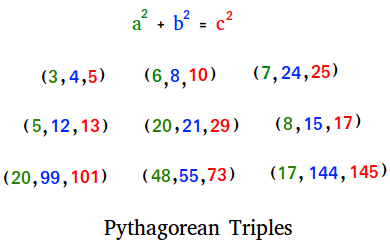Pythagorean Triples
Pythagorean triples, also called Pythagorean triplets, are sets of three whole numbers a,b, and c bigger than zero such that a2 + b2 = c2
The numbers a, b, and c are put inside parenthesis as (a, b, c) or the triple can be written as a, b, c without parenthesis.
Notice that c is listed last and that is very important!
Take a look at the figure below showing a list of nine Pythagorean triples.

The most common Pythagorean triples are (3,4,5), (5, 12, 13), (6, 8, 10), (7, 24, 25), and (8, 15, 17). You will often see these triples in math textbooks and exercises. No doubt, (3, 4, 5) is used more than any other Pythagorean triple!
If you carefully look at the list above and examine it, you will also notice that a Pythagorean triple either has only even numbers or only one even number and two odd numbers.
The definition comes right from the Pythagorean Theorem which states that for all integers a, b, and c, c2 = a2 + b2
Notice that c is the longest side or the hypotenuse of a right triangle and a and b are legs of a right triangle.
How to find Pythagorean triples
Example #1
32 + 42 = 52
The triple is (3, 4, 5) is the smallest Pythagorean triple. We can use it to find one or more triples.
Notice that 32 + 42 = 9 + 16 = 25 and 52 = 25
How would you generate another triple?
Just multiply both sides of the equation below by 22
32 + 42 = 52
22 × 32 + 22 × 42 = 22 × 52
(2 × 3)2 + (2 × 4)2 = (2 × 5)2
62 + 82 = 102 and the Pythagorean triple is (6,8,10)
You could have found the answer a lot faster than that by multiplying each number of the triple (3, 4, 5) by 2.
In general, once you have a triple, you can multiply this triple by any positive integer to generate another one.
Example #2
52 + 122 = 132
The triple is (5, 12, 13)
Notice again that if 52 + 122 = 132, then 25 + 144 is indeed equal to 169
How would you generate another triple?
Just multiply both sides of the equation below by 32 this time.
52 + 122 = 132
32 × 52 + 32 × 122 = 32 × 132
(3 × 5)2 + (3 × 12)2 = (3 × 13)2
152 + 362 = 392
Again, you could have found the answer a lot faster by multiplying each number of the triple (5, 12, 13) by 3.
Here is a little exercise: Is (4, 5, 7) is triple?
Is 42 + 52 = 72 ?
42 + 52 = 16 + 25 = 41. However, 72 = 49. So, (4, 5, 7) is not a triple.
Primitive Pythagorean triple
If the greatest common factor of a, b, and c of a triple (a, b, c) is equal to 1, then the triple is a primitive Pythagorean triple.
For example, (5, 12, 13) is a primitive Pythagorean triple. However, (9, 12, 15) is a non-primitive Pythagorean triple since the greatest common factor of 9, 12, and 15 is 3.
Plato's formula for generating Pythagorean Triples:
Plato, a Greek Philosopher, came up with a great formula for finding Pythagorean triples.
(2m)2 + (m2 - 1)2 = (m2 + 1)2
To get a triple, just let m be any positive integer and do the math.
Let m = 2 for instance, we get:
(2m)2 + (m2 - 1)2 = (m2 + 1)2
(2×2)2 + (22 - 1)2 = (22 + 1)2
(4)2 + (4 - 1)2 = (4 + 1)2
(4)2 + (3)2 = (5)2
Thus, the Pythagorean triple is (3, 4, 5)
Let m = 5 for instance, we get:
(2m)2 + (m2 - 1)2 = (m2 + 1)2
(2×5)2 + (52 - 1)2 = (52 + 1)2
(10)2 + (25 - 1)2 = (25 + 1)2
(10)2 + (24)2 = (26)2
Thus, the triple is (10, 24, 26)
Indeed (10)2 + (24)2 = 100 + 576 = 676 and 262 = 26 × 26 = 676
Euclid's formula for generating Pythagorean triples:
If m and n are arbitrary positive integers with m > n > 0, then you can use the following formula to find both primitive and non-primitive triples:
a = m2 - n2
b = 2mn
c = m2 + n2
Let m = 2 and n = 1
a = 22 - 12 = 4 - 1 = 3
b = 2(2)(1) = 4
c = 22 + 12 = 4 + 1 = 5
We get the primitive Pythagorean triple (3, 4, 5)
Let m = 3 and n = 2
a = 32 - 22 = 9 - 4 = 5
b = 2(3)(2) = 12
c = 32 + 22 = 9 + 4 = 13
We get the primitive Pythagorean triple (5, 12, 13)
Let m = 6 and n = 2
a = 62 - 22 = 36 - 4 = 32
b = 2(6)(2) = 24
c = 62 + 22 = 36 + 4 = 40
We get the non-primitive Pythagorean triple (32, 24, 40)